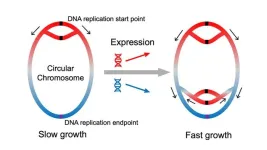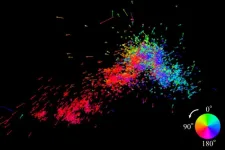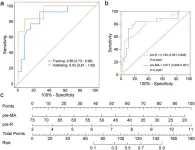(Press-News.org) Bioinformaticians from Heinrich Heine University Düsseldorf (HHU) and the university in Linköping (Sweden) have established that the genes in bacterial genomes are arranged in a meaningful order. In the renowned scientific journal Science, they describe that the genes are arranged by function: If they become increasingly important at faster growth, they are located near the origin of DNA replication. Accordingly, their position influences how their activity changes with the growth rate.
Are genes distributed randomly along the bacterial chromosome, as if scattered from a salt shaker? This opinion, which is held by a majority of researchers, has now been disputed by a team of bioinformaticians led by Professor Dr Martin Lercher, head of the research group for Computational Cell Biology at HHU.
When bacteria replicate their genetic material in preparation for cell division, the process starts at a specific point on the bacterial chromosome and continues along the chromosome in both directions.
Dr Xiao-Pan Hu from HHU, lead author of the study now published in Science: “For a short time during this process, there are more copies of those genes located closer to the origin of replication than of those located further away. Accordingly, genes close to the origin can be read more frequently.”
“We have established that these genes are particularly important for cell growth – e.g. those whose products assemble the proteins of the bacteria,” adds Professor Lercher, corresponding author of the study. By contrast, genes rarely needed in the growth phases are usually found at the opposing end of the chromosome, where they are duplicated late in the process.
The researchers used bioinformatic and mathematical methods to analyse the positions of more than 4,400 gene families in over 900 different bacterial species. They found that the positioning of the genes along the chromosome must have arisen as a consequence of evolutionary pressure, as those bacteria that can grow particularly quickly as a result of optimally placed genes have an evolutionary advantage.
Dr Hu: “We now understand better how bacteria control their genes. The results really surprised us. They provide an excellent explanation of an important aspect of bacterial evolution: The right genomic positioning gave the bacteria existing today an advantage over their rivals.”
Lercher on further potential applications: “This understanding can also help design more efficient synthetic bacteria, e.g. for biotechnological or medical applications.”
Original publication
Xiao-Pan Hu, Bayu Brahmantio, Krzysztof Bartoszek, Martin J. Lercher. Most bacterial gene families are biased toward specific chromosomal positions. Science 388/6743 (2025).
DOI: 10.1126/science.adm9928
END
Drawing board rather than salt shaker
Bioinformatics: Publication in Science
2025-04-10
ELSE PRESS RELEASES FROM THIS DATE:
Engineering invites submissions on AI for engineering
2025-04-10
Artificial intelligence (AI) is playing an increasingly pivotal role in revolutionizing the field of engineering, triggering a new era of technological and industrial evolution. A series of recent breakthroughs in areas like natural language processing, computer vision, and machine learning, with the Nobel Prize-winning work in artificial neural networks and protein structure prediction serving as prime examples, have effectively bridged the gap between the physical and digital worlds. The emergence of general AI technologies, especially large language models, has given rise ...
In Croatia’s freshwater lakes, selfish bacteria hoard nutrients
2025-04-10
Bacteria play key roles in degrading organic matter, both in the soil and in aquatic ecosystems. While most bacteria digest large molecules externally, allowing other community members to share and scavenge, some bacteria selfishly take up entire molecules before digesting them internally. In a paper publishing April 10 in the Cell Press journal Cell Reports, researchers document “selfish polysaccharide uptake” in freshwater ecosystems for the first time. In Croatia’s Kozjak and Crniševo Lakes, they found that nutrient hoarding allows selfish species ...
Research suggests our closest neighboring galaxy may be being torn apart
2025-04-10
A team led by Satoya Nakano and Kengo Tachihara at Nagoya University in Japan has revealed new insights into the motion of massive stars in the Small Magellanic Cloud (SMC), a small galaxy neighboring the Milky Way. Their findings suggest that the gravitational pull of the Large Magellanic Cloud (LMC), the SMC’s larger companion, may be tearing the smaller one apart. This discovery reveals a new pattern in the motion of these stars that could transform our understanding of galaxy evolution and interactions. The results were published ...
Researchers identify factors in early-life linked to body fat in South Asian children
2025-04-10
Researchers at McMaster University have identified six key factors in the first three years of life that influence the trajectory of obesity in South Asian children.
The findings offer parents, primary care practitioners and policymakers new insights into addressing childhood obesity for a group of children who have a higher prevalence of abdominal fat and cardiometabolic risk factors, as well as a predisposition to diabetes.
“We know that current measures of childhood obesity such as the body mass index (BMI) don’t work well for South Asians because of the so called ‘thin-fat’ phenotype: South Asian newborns are characterized as low birth weight, but proportionally ...
Environment: Less than 10% of global plastics manufactured from recycled materials
2025-04-10
Only 9.5% of plastic materials produced globally in 2022 were manufactured from recycled materials. The findings, reported in Communications Earth & Environment, are part of a comprehensive analysis of the global plastics sector, which also reveals a large increase in the amount of plastic being disposed of by incineration and substantial regional differences in plastic consumption.
Plastic production has increased from two million tonnes per year in 1950 to 400 million tonnes per year in 2022 and ...
Influenza vaccination among people with Medicare by race and ethnicity, education, and rurality
2025-04-10
About The Study: In this cross-sectional survey study, although overall influenza vaccination rates changed little from 2019 to 2022, they increased substantially for Black and Hispanic older adults, particularly those in rural areas, and decreased for some groups of white older adults. Determining the reasons for these divergent changes in influenza vaccination rates is a high priority for future research.
Corresponding Author: To contact the corresponding author, Marc N. Elliott, PhD, email elliott@rand.org.
To access the embargoed study: Visit our For The Media website at this link https://media.jamanetwork.com/
(doi:10.1001/jamanetworkopen.2025.4462)
Editor’s ...
Neighborhood characteristics and mental health from childhood to adolescence
2025-04-10
About The Study: In this cohort study of children and adolescents, associations between neighborhood characteristics and mental health evolved from childhood through adolescence. These findings suggest that targeted interventions in disadvantaged neighborhoods and strategies to protect young children from air pollution are essential. A comprehensive approach is recommended to incorporate air pollution, green space, and socioeconomic status not only in residential neighborhoods but also in other settings, such as schools.
Corresponding Author: To contact the ...
Centrifugation liver support using regional mesylate anticoagulation is safe for liver failure patients with high risk of bleeding
2025-04-10
Background and objectives
Patients with acute liver failure (ALF) or acute-on-chronic liver failure (ACLF) are at high risk of bleeding with traditional artificial liver support systems. To address the bleeding risk in liver failure patients, the safety of regional mesylate anticoagulation (RMA) in centrifugation artificial liver support systems (cALSS) is proposed for study.
Methods
In this prospective single-arm study, ALF and ACLF patients were treated with cALSS using RMA. Coagulation function was monitored, and the predictors of mesylate dose were analyzed ...
Cancer Research Changed My Life campaign shows personal impact of scientific discoveries
2025-04-10
April 10, 2025, ONTARIO — A yearlong campaign from the Ontario Institute for Cancer Research (OICR) is celebrating the profound difference cancer research is making in the lives of Ontarians.
Cancer Research Changed My Life showcases the people behind research discoveries, bringing their personal stories to life through videos and first-person testimonials.
As the province’s cancer research institute, OICR brings together a community of scientists, cancer patients, clinicians and everyday Ontarians to solve cancer ...
AERA announces 2025 award winners in education research
2025-04-10
Washington, April 10, 2025—The American Educational Research Association (AERA) has announced the winners of its 2025 awards for excellence in education research.
“We are pleased to present the 2025 awards to this commendable and exemplary group of education scholars and champions,” said AERA Executive Director Felice J. Levine. “They have contributed tremendously to education research, across all career stages and fields, and continue to make a difference in the lives of students and educators.”
AERA will honor the recipients at the Awards Ceremony Luncheon at the 2025 Annual Meeting in Denver on ...
LAST 30 PRESS RELEASES:
The impact of family dynamics on eating behaviour – how going home for Christmas can change how you eat
Tracing the quick synthesis of an industrially important catalyst
New software sheds light on cancer’s hidden genetic networks
UT Health San Antonio awarded $3 million in CPRIT grants to bolster cancer research and prevention efforts in South Texas
Third symposium spotlights global challenge of new contaminants in China’s fight against pollution
From straw to soil harmony: International team reveals how biochar supercharges carbon-smart farming
Myeloma: How AI is redrawing the map of cancer care
Manhattan E. Charurat, Ph.D., MHS invested as the Homer and Martha Gudelsky Distinguished Professor in Medicine at the University of Maryland School of Medicine
Insilico Medicine’s Pharma.AI Q4 Winter Launch Recap: Revolutionizing drug discovery with cutting-edge AI innovations, accelerating the path to pharmaceutical superintelligence
Nanoplastics have diet-dependent impacts on digestive system health
Brain neuron death occurs throughout life and increases with age, a natural human protein drug may halt neuron death in Alzheimer’s disease
SPIE and CLP announce the recipients of the 2025 Advanced Photonics Young Innovator Award
Lessons from the Caldor Fire’s Christmas Valley ‘Miracle’
Ant societies rose by trading individual protection for collective power
Research reveals how ancient viral DNA shapes early embryonic development
A molecular gatekeeper that controls protein synthesis
New ‘cloaking device’ concept to shield sensitive tech from magnetic fields
Researchers show impact of mountain building and climate change on alpine biodiversity
Study models the transition from Neanderthals to modern humans in Europe
University of Phoenix College of Doctoral Studies releases white paper on AI-driven skilling to reduce burnout and restore worker autonomy
AIs fail at the game of visual “telephone”
The levers for a sustainable food system
Potential changes in US homelessness by ending federal support for housing first programs
Vulnerability of large language models to prompt injection when providing medical advice
Researchers develop new system for high-energy-density, long-life, multi-electron transfer bromine-based flow batteries
Ending federal support for housing first programs could increase U.S. homelessness by 5% in one year, new JAMA study finds
New research uncovers molecular ‘safety switch’ shielding cancers from immune attack
Bacteria resisting viral infection can still sink carbon to ocean floor
Younger biological age may increase depression risk in older women during COVID-19
Bharat Innovates 2026 National Basecamp Showcases India’s Most Promising Deep-Tech Ventures
[Press-News.org] Drawing board rather than salt shakerBioinformatics: Publication in Science



